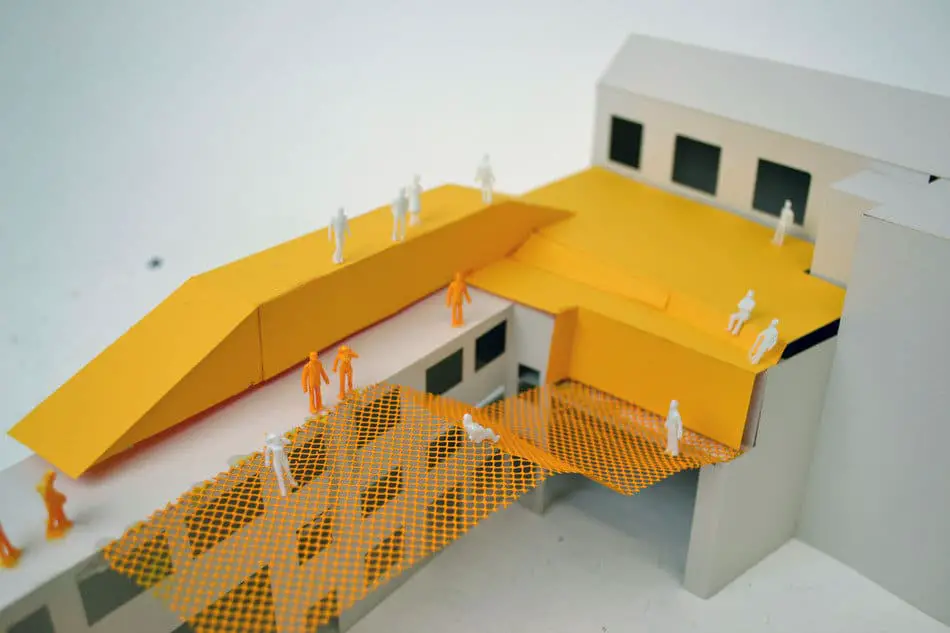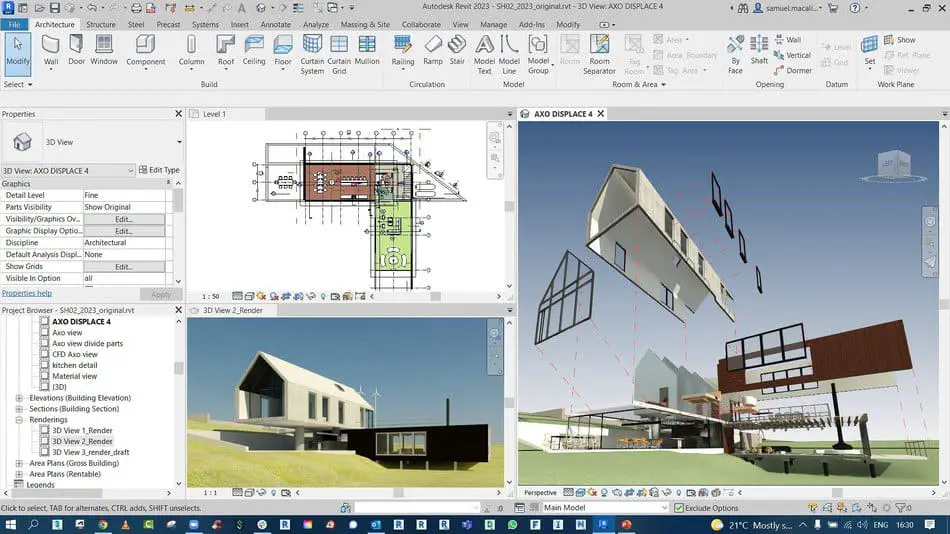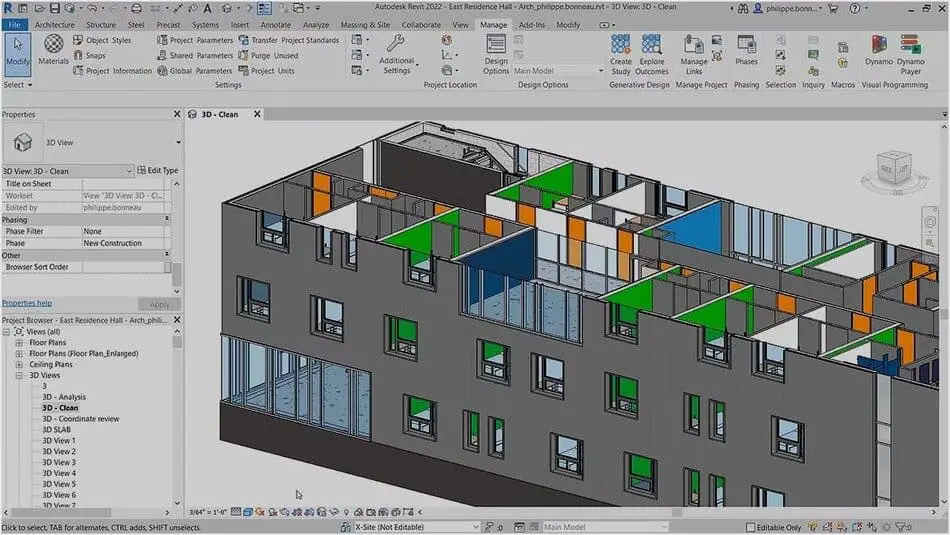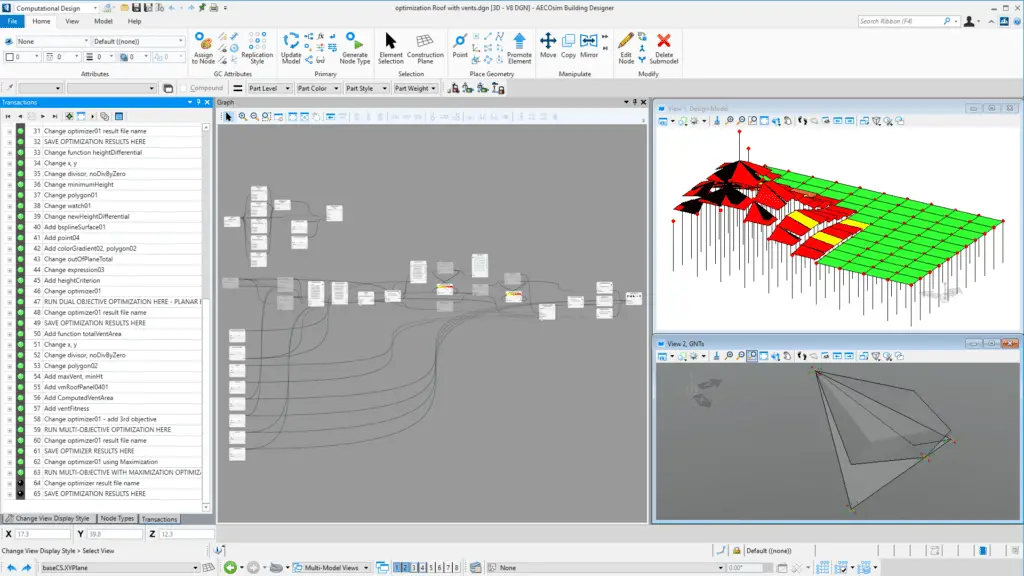Yes, architects will be needed in the future. The role of the architect is likely to evolve, and architects must embrace new technologies. However, at this time and for the foreseeable future, there are many aspects of an architect’s role that are impossible for computers or artificial intelligence to replace, such as creative design, communication, collaboration & decision-making.
Computers will not replace the work of an architect for the foreseeable future. Computers are allowing architects to design with more complexity and in a more efficient way. Still, it will be a long time until a robot can replace architects altogether.

The Data
According to Will Robots Take My Job there is a 0% chance that the role of the architect will become fully automated, describing architecture as a ‘Totally Safe’ profession. This is excellent news if you’re considering architecture as a career.

A study by the BBC showed that architects had a 2% chance of automation. This ranked 338th out of 366, making architecture one of the safest professions.
To understand why architects won’t be replaced by robots any time soon, we need to first understand what an architect does.
What Can An Architect Do That A Computer Can’t
While computers can assist architects in many aspects of their work, certain tasks still require human input and decision-making. Here are a few examples:
Creativity and Design Thinking
Computers can help generate design options and assist with tasks such as drafting and modelling, but they cannot replace the creativity and design thinking of an architect. Developing innovative solutions to complex problems requires a level of human intuition and inspiration that a machine cannot replicate.

Communication and Collaboration
Architects must work closely with clients, contractors, engineers, and other stakeholders throughout the design and construction process. Effective communication and collaboration require human skills such as empathy, negotiation, and interpersonal relationships, which a computer cannot replace.
Quality Control & Problem-solving
A crucial part of an architect’s job is visiting a building site to ensure that what is constructed matches what was designed and drawn. If issues are noticed by the architect, they must work with the building contractor to find a solution and decide how to fix the problem.

An architect will often visit the building site during a project’s construction to ensure everything is going to plan. This part of the job is impossible without a human presence.
Contextual Understanding
Architecture is not just about creating aesthetically pleasing buildings; it also involves deeply understanding the surrounding environment, culture, history, and context. This requires human skills such as observation, research, and critical thinking, which computers cannot.

Judgment and Decision-Making
While computers can provide data and analytics to support decision-making, a human architect must make the final judgment. This includes weighing trade-offs, considering the needs of different stakeholders, and balancing competing priorities to arrive at the best solution.
Ultimately, a human must be held accountable for any problems arising during a construction project.
Model Making
Whilst technology is changing the way models are made, there are still limitations in the precision, materials and cost efficiency provided by 3D printing, laser cutting and CNC machines. A human is also required to assemble a model produced in this way, and it is often more cost-efficient to create architectural models by hand.

Overall, while computers can assist architects in many aspects of their work, the unique combination of creativity, communication, contextual understanding, and judgment required in architecture means that there will always be essential aspects of the job that cannot be done by a machine alone.
How Is Technology Changing The Role Of The Architect?
Technology has significantly changed the role of the architect in recent years. Here are some ways in which technology has impacted the profession:
Design
Technology has enabled architects to create more accurate and realistic designs using 3D modeling software such as Revit, SketchUp, and Rhino.
Digital modeling enables an architect to quickly change a design and create iterations of the same design. In addition, these models can be instantly shared with colleagues and collaborators, speeding up the design process.

Digital 3D models have also made it easier to communicate ideas to people who are less comfortable interpreting traditional architectural drawings without the cost of building a physical 3D model. This is particularly important when presenting ideas to clients and stakeholders.
Visualization
Digital visualization of a design enables the architect to see how their building will look in reality with realistic materials and lighting. This can aid the design process and help communicate the design intention to colleagues and clients.

Real-time visualization software such as Enscape or Twinmotion enables a design to be viewed with realistic lighting and textures without the need for rendering. It is possible to move around a 3D model, allowing it to be seen from any angle, and it can even be viewed using a virtual reality headset. This makes the experience even more true to life.
Collaboration
With cloud-based software and communication tools, architects can collaborate with team members and clients in real-time, regardless of their physical location. This has allowed for more efficient workflows and better communication throughout the design process.
Cloud storage solutions such as DropBox allow team members to access the same files from any location in the world. These can be viewed and edited by anyone who has access. Any changes will update automatically, allowing all team members to view up-to-date project information.
Collaborative whiteboard software such as Miro allows a team to brainstorm ideas simultaneously. Team members can add images, make notes and even draw in real-time. This allows brainstorming and creative collaboration to be carried out remotely, something previously done around a table or on a pin-up board.

Sustainability
Technology has enabled architects to design more sustainable buildings by providing access to tools and resources for energy modeling, building performance analysis, and integrating renewable energy systems.
We now also have the ability to analyze the energy efficiency of buildings across multiple parameters. This data can be fed back into the design process, making future designs even more sustainable.
Building Information Modeling (BIM)
BIM is a digital representation of the physical and functional characteristics of a building. It enables architects and engineers to create a detailed, accurate, and coordinated model of the building between disciplines. This allows the team to ensure that there are no clashes between architecture, structural elements, pipework, ductwork, electrical cabling, and much more, depending on the type and scale of the project.

Essentially, an exact replica of the building is created in BIM software before the building is constructed.
This 3D model is also shared with contractors and other stakeholders to ensure the construction process is as smooth as possible.
BIM has revolutionized how architects, engineers, and contractors design and manage construction projects.
Automation
Automation technologies like artificial intelligence and machine learning are beginning to impact the role of architects. These technologies can help automate repetitive tasks and streamline workflows, allowing architects to focus on more creative and strategic work.
Overall, technology has enabled architects to work more efficiently, collaborate more effectively, and create better designs. As technology advances, the architect’s role will likely continue to evolve and adapt to new tools and techniques.
Do architects use AI?
Yes, architects and architecture practices such as Foster & Partners and Heatherwick Studio already use artificial intelligence (AI).
AI can assist architects in various ways, including:
Design Optimization
AI algorithms can analyze design options and provide recommendations for optimizing design performance based on specified parameters such as energy efficiency, structural stability, and cost.
Generative Design
AI can generate various design options based on input criteria, allowing architects to explore many possibilities quickly.
Analysis and Simulation
AI can analyze complex data sets and simulate various scenarios to help architects make informed design decisions.
Project Management
AI can automate repetitive tasks and help manage project schedules and budgets.
Sustainability
AI can help architects design more sustainable buildings by analyzing environmental data and recommending strategies for reducing energy consumption and minimizing the building’s carbon footprint.
Overall, AI can help architects streamline their workflow, save time, and make better-informed design decisions.
One of Britain’s most prominent architecture practices, Fosters + Partners, actively embraces artificial intelligence. Their Applied Research and Development group looks at how designers can work alongside new technologies, using Ai to reduce mundane and routine tasks and “optimize and push the boundaries” of their designs. Read more about this research here: https://www.fosterandpartners.com/plus-journal/towards-artificial-intelligence-in-architecture/
How will Ai change architecture?
Artificial intelligence (AI) is already changing architecture in many ways, and it is expected to have an even more significant impact in the future. Here are some of the ways AI is changing architecture:
Design and Planning
AI-powered software can generate complex design options, analyze them based on various parameters, and suggest the most efficient and effective design solutions. AI can also help architects and urban planners predict how their designs will impact the environment, traffic, and other factors.
Construction
AI can help streamline the construction process by analyzing construction sites, managing resources and schedules, and ensuring safety and quality. AI-powered robots and drones can also perform tasks that are too dangerous or difficult for humans, such as surveying and inspection.
Sustainability
AI can help architects and builders optimize building performance and energy efficiency, reducing the environmental impact of buildings. AI can also help predict how buildings will perform in extreme weather conditions and natural disasters, allowing architects to design more resilient structures.
Maintenance
AI-powered sensors and monitoring systems can track building performance and detect potential issues, allowing for proactive maintenance and repairs. AI can also help optimize building operations, such as heating, cooling, and lighting, to reduce energy consumption and costs.
Overall, AI has the potential to revolutionize architecture by enabling faster, more efficient, and more sustainable design and construction processes. However, it is vital for architects and builders to carefully consider the ethical implications of AI and ensure that it is used responsibly and equitably.
The Best AI Tools For Architects
Artificial intelligence (AI) can revolutionize architecture, allowing architects to design buildings that are more efficient, sustainable, and aesthetically pleasing. Here are some of the best AI tools that architects can use:
Generative Design Software
Generative design software uses algorithms to generate numerous design options based on specific criteria such as size, materials, and environmental factors. Architects can use this software to explore a wide range of design possibilities, optimize their designs, and save time at the early stages of the design process.

Building Performance Analysis Software
Building performance analysis software such as Spacemaker uses AI algorithms to simulate the performance of buildings under various environmental conditions. Architects can use this software to optimize their designs for energy efficiency, thermal comfort, and other factors.
Tools like this are not currently widespread, but it is thought that AI will completely revolutionize building analysis.
Image Generators
AI image generation tools such as DALL-E and Midjourney AI can assist architects with concept development and image creation for their projects. These images are generated by inputting a simple prompt, which can be edited and improved with further instruction.
One architect who is taking advantage of this technology is Jose Sanchez. He has been using Midjourney to create photorealistic architectural visualizations nearly indistinguishable from professional renders. You can see his work on Instagram at @jomasan



Chat GPT
Chat GPT is an AI chat generation tool that is getting much attention worldwide. This tool can be utilized by architects for compiling text documents as part of competition entries and planning applications. It can be advantageous if the architect is working in a language that is not their mother tongue.
Chat GPT can also create code for software such as Grasshopper. This allows scripts to be written by designers who have yet to gain advanced coding knowledge.
Overall, AI tools offer architects a range of benefits, from increased efficiency and accuracy to improved sustainability and aesthetics. By incorporating these tools into their workflows, architects can create better designs and improve the overall quality of the built environment.
5 Generative Design Software That Architects Can Use
There are several examples of generative design software that architects can use. Here are a few examples:
1. Revit
Generative design has been a feature that is available in Revit since 2021 as part of its architecture, engineering, and construction package.
This allows the user to rapidly generate design alternatives in response to specific goals, constraints, and inputs, which can then be explored and optimized.
Using a tool like this is much faster than creating numerous iterations manually.
You can find out more about generative design in Revit here: https://www.autodesk.com/collections/architecture-engineering-construction/building-design?plc=AECCOL&term=1-YEAR&support=ADVANCED&quantity=1#internal-link-generative-design-in-revit
2. Rhino/Grasshopper
Rhino is a 3D modeling software commonly used in architecture. Grasshopper is a plugin for Rhino that allows architects to create generative design algorithms.
Grasshopper is a powerful design tool capable of a whole host of things to assist an architect with their design work. One of these tools is generative design.
Rhino is a much less expensive alternative to Revit, and the grasshopper plugin is entirely free.
3. Bentley Systems – GenerativeComponents
GenerativeComponents is a parametric modeling software created by the makers of MicroStation. The software allows designers to quickly generate multiple iterations of their designs based on a series of constraints and parameters.

Similar to the generative design feature in Revit, this software can make the early project design phases much more efficient.
4. Autodesk Spacemaker
Spacemaker is a cloud-based AI software that enables architects, urban planners, and real estate developers to create site proposals and the early stages of projects.
The software allows users to explore how a given site could be used and optimized using real-time data such as noise, wind, sun, and microclimate.

Spacemaker is a cloud-based software that enables slick collaboration between team members anywhere in the world.
Spacemaker was purchased by Autodesk in 2020.
Find out more about Spacemaker here: https://www.autodesk.com/products/spacemaker/overview
13 Ways That Architects Use Technology To Optimize Their Work
Architects use a wide range of technologies in their work to aid in the design, visualization, and construction of buildings. Here are some examples:
Computer-aided Design (CAD) Software
Architects use CAD software to create and manipulate digital 2D and 3D models of buildings. This allows them to experiment with different design options and make changes quickly and easily.
Building Information Modeling (BIM) Software
BIM software allows architects to create detailed 3D models of buildings that include information about materials, systems, and processes. This information can be used by contractors, engineers, and other stakeholders to optimize the construction and operation of the building.
Virtual Reality (VR) and Augmented Reality (AR)
Architects can use VR and AR to create immersive experiences that allow clients and stakeholders to visualize and interact with building designs more realistically. This technology can help architects communicate design ideas more effectively and identify potential issues before construction begins.
3D Printing
Architects can use 3D printing technology to create physical models of buildings, which can be helpful for visualization, testing, and presentation purposes.
Drones
Architects can use drones to capture aerial images and videos of construction sites, providing valuable information about site conditions and progress.
Energy Modeling Software
Architects can use energy modeling software to simulate how a building will perform regarding energy efficiency and sustainability. This information can be used to optimize the building’s design and operation.
Geographic Information Systems (GIS)
Architects can use GIS software to analyze data related to a building site, including topography, soil conditions, and proximity to other buildings or landmarks.
Project Management Software
Architects use project management software to manage project timelines, budgets, and resources. This software can help architects stay organized and ensure that projects are completed on time and within budget.
Structural Analysis Software
Architects use structural analysis software to test the structural integrity of building designs and ensure they can withstand different types of stress and pressure.
Environmental Simulation Software
Architects can use environmental simulation software to simulate how a building will perform under different environmental conditions, such as wind, sun, and rain. This information can be used to optimize building design and performance.
Cloud Computing
Cloud computing services provide architects access to powerful computing resources and storage capabilities. This can be especially useful for architects working with large and complex data sets, such as 3D models.
Mobile Devices and Apps
Architects can use mobile devices and apps to stay connected and productive while on the go. For example, architects can use mobile apps to take notes, make sketches, and collaborate with colleagues.
Laser Scanning
Architects can use laser scanning technology to capture accurate measurements and 3D models of existing buildings or sites. This information can be used to inform renovation or restoration projects.
These are just a few examples of how architects use technology in their work. As technology continues to evolve, we can expect architects to find new and innovative ways to leverage it to create better buildings and spaces.
What is the future of architecture and design?
The future of architecture and design will likely be influenced by various factors, including technological advancements, sustainability concerns, changing demographics, and shifting cultural trends. Here are some potential developments that could shape the future of architecture and design:
- Increased use of automation and artificial intelligence (AI) in the design and construction process. Architects and designers may use AI to create more accurate and efficient designs, optimize building performance, and reduce costs.
- Greater emphasis on sustainability and green design. As the effects of climate change become more apparent, there will be a growing demand for environmentally friendly and energy-efficient buildings. Architects and designers will need to incorporate sustainable design principles into their work.
- The rise of smart cities and intelligent buildings. With the proliferation of Internet of Things (IoT) technology, facilities, and cities are becoming more interconnected and data-driven. This could lead to the creation of more efficient, responsive, and livable urban environments.
- The increasing importance of health and well-being in building design. Architects and designers may prioritize features that promote physical and mental health, such as natural light, green spaces, and air purification systems.
- More diverse and inclusive design. As society becomes more varied, architects and designers must consider the needs and preferences of a wider range of users, including those with disabilities or from different cultural backgrounds.
Overall, the future of architecture and design is likely to be characterized by innovation, sustainability, and a focus on improving the quality of life for users.

